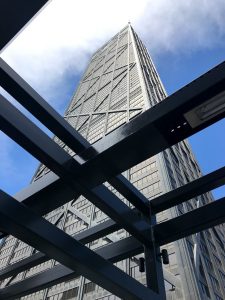At Greenbuild 2018, chemistry helps build sustainability
by American Chemistry | November 13, 2018
Photograph courtesy of Todd Sims
This week in Chicago, architects, designers, builders and product manufacturers are gathering at Greenbuild 2018, to learn about, discuss and be inspired by the latest trends in high-performance, sustainable, resilient buildings designed and constructed with the goal of helping to enhance our health and well-being.
“Human By Nature,” the Greenbuild 2018 theme, reflects this connection, to highlight how building for sustainability can benefit building occupants, our communities and the natural environment all around us.
The benefits of “building green” are numerous – resilient buildings can better withstand impacts from extreme weather like hail and winds; energy-efficiency improvements help buildings save energy and reduce reliance on natural resources; well insulated homes are less likely to lose warm or cool air, which can result in lower utility bills, reduced greenhouse gas emissions and improved indoor air quality. In addition, the products of chemistry can play a critical role in making these benefits, and others, possible.
Today, the chemical industry’s brightest scientists, engineers and researchers are transforming molecules to create a wide array of materials and products that contribute to sustainable, resilient buildings. For example:
- “Greener,” bio-based carpet. DuPont developed a bio-based co-polymer through a fermenting process, using plant-based resources, similar to the process for making beer and wine. DuPont uses this Sonora co-polymer to create soft, stain-resistant carpets made from renewable resources.
- Sustainable mattresses and furniture. Scientists at Covestro have developed a breakthrough technology – a catalyst that makes it possible to harness carbon dioxide molecules and convert them into a precursor for flexible polyurethane foam found in products like upholstered furniture, bedding and more.
- Engineered wood from a circular economy. Hexion’s EcoBindTM resin technology helps manufacturers recover more usable wood from trees, resulting in a variety of engineered wood products for use in building materials. Thanks to this technology, engineered wood panels can be made from recovered wood waste that might otherwise be burned or disposed of in a landfill.
- Nanotechnology-powered smart windows. 3M has developed a nano-tech film made of micro-structured prisms for windows that can optically redirect up to 80 percent of daylight upward and diffuse it for even distribution throughout a room without heating it up.
- Structural insulated panels (SIPs) with high R-values. BASF produces structural insulated panels for walls made from graphite polystyrene (GPS) insulation, which helps boost a panel’s R-values even higher, enhancing energy efficiency throughout the building envelop.
- Innovative flooring materials. Milliken & Company recently earned the first WELL Platinum project certification in Chicago, and flooring materials helped pave the way. Milliken manufactures its luxury vinyl tiles using a closed-loop recycling process where all production waste is granulated and put back into tile production.
- Resilient green roofing systems. Sika uses its knowledge in the material sciences to produce waterproofing membranes for green or vegetative roofing systems. Green roofing systems can help make communities more resilient by reducing stress on urban sewer systems and decreasing run-off related pollution in waterways.
Attending Greenbuild 2018?
If you are in Chicago this week, check out the Greenbuild Materials Journey Map, sponsored by ACC, which can help architects and designers learn more about materials-focused events and experiences at Greenbuild.
ACC is also sponsoring two lunch and learn sessions at Greenbuild:
- Driving Sustainability: The Importance of Collaboration and Transparency
Wednesday, November 14, from noon to 1 p.m., at Booth 163
Innovative products and materials that go in to constructing LEED-certified buildings, like energy efficient insulation and green roofs, began as breakthroughs in chemistry. Learn more about supply chain initiatives to accelerate sustainable building and construction.
Learn about two LEED v4 pilot credits designed to provide important health, safety, environmental and life cycle information on building products to help architects and project teams make informed material selection decisions.
To learn more about how chemicals are the building blocks for many high-performing materials, visit BuildingwithChemistry.org.
